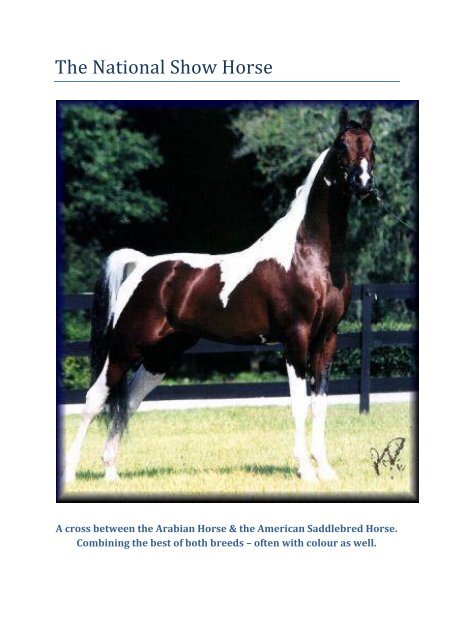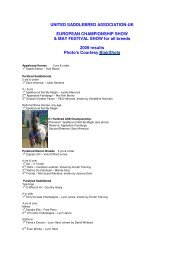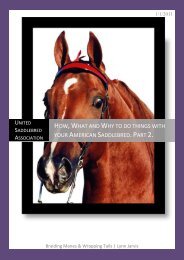The National Show Horse - American Saddlebred Association UK
The National Show Horse - American Saddlebred Association UK
The National Show Horse - American Saddlebred Association UK
Create successful ePaper yourself
Turn your PDF publications into a flip-book with our unique Google optimized e-Paper software.
<strong>The</strong> <strong>National</strong> <strong>Show</strong> <strong>Horse</strong><br />
A cross between the Arabian <strong>Horse</strong> & the <strong>American</strong> <strong>Saddlebred</strong> <strong>Horse</strong>.<br />
Combining the best of both breeds – often with colour as well.
<strong>The</strong> <strong>National</strong> <strong>Show</strong> <strong>Horse</strong> must possess only Arabian and <strong>American</strong> <strong>Saddlebred</strong> bloodlines –<br />
with at least 25% up to 99% being Arab, the remainder being solely <strong>Saddlebred</strong>, although<br />
the vast majority will be straight crosses (50%). Obviously those <strong>National</strong> <strong>Show</strong> <strong>Horse</strong>s that<br />
have a lot of Arabian blood will resemble Arabians and those with a lot of <strong>Saddlebred</strong> blood<br />
will resemble <strong>Saddlebred</strong>s there is no right or wrong to this your <strong>National</strong> <strong>Show</strong> <strong>Horse</strong> will<br />
resemble the breed that appeals to you the most. <strong>The</strong> two separate breeds are shown in a<br />
similar fashion in America and so is this exciting new crossbreed, the <strong>National</strong> <strong>Show</strong> <strong>Horse</strong>.<br />
Exhibited with a full mane and tail, the <strong>National</strong> <strong>Show</strong> <strong>Horse</strong> is trotted into the ring, stood<br />
up for inspection and then trotted again. Often the breed has a trimmed bridle path and<br />
braids in his forelock and mane, reflecting his <strong>Saddlebred</strong> heritage.<br />
<strong>The</strong> <strong>National</strong> <strong>Show</strong> <strong>Horse</strong> combines the refinement of the Arabian with the animation of the<br />
<strong>Saddlebred</strong>, resulting in a high-set, upright, long, swan-like neck of the <strong>Saddlebred</strong>, without<br />
a pronounced crest. <strong>The</strong> head is usually refined and small, with small ears and either a<br />
straight or concave profile. <strong>The</strong> horses are close-coupled with a level topline and have a very<br />
deep, laid back shoulde with the tail carried high. <strong>The</strong>re are no minimum or maximum<br />
heights to the <strong>National</strong> <strong>Show</strong> <strong>Horse</strong>, although most will fall in the 15hh-16hh range.<br />
<strong>The</strong> <strong>National</strong> <strong>Show</strong> <strong>Horse</strong> can come in any colour – the more colourful representatives<br />
coming from the <strong>Saddlebred</strong> ancestry. Due to the <strong>Saddlebred</strong> ancestry it is also possible to<br />
have gaiting <strong>National</strong> <strong>Show</strong> <strong>Horse</strong>s.<br />
Some <strong>UK</strong> <strong>National</strong> <strong>Show</strong> <strong>Horse</strong>s:
<strong>The</strong> <strong>National</strong> <strong>Show</strong> <strong>Horse</strong> shall strive to produce an athletic horse which retains size, beauty<br />
and refinement. Specifically, the following traits are desirable:<br />
A. Motion. Balanced and obvious power from the hindquarters flowing into an elevated<br />
front end, the front legs showing both flexion and extension;<br />
B. Neck. Very long, set high on the shoulder and relatively upright with fine throatlatch.<br />
<strong>The</strong> neck should be shapely but without a pronounced crest;<br />
C. Head. Relatively small, short and refined with large eyes and small, well placed ears and<br />
a straight or slightly concave profile (a "Roman nosed" or convex profile is not desirable);<br />
D. Pronounced withers and a very deep and well laid back shoulder;<br />
E. Proportionately short back closely coupled with a long hip and relatively level top line<br />
(moderately sloping croup not to be penalized);<br />
F. Legs. Correct from all angles with long forearms and short cannon bones in front and<br />
long, well angled pasterns front and rear;<br />
G. Refinement of bone but not lacking in substance, especially in the chest, girth, shoulder<br />
and hip;<br />
H. A relatively high set tail, natural and flowing;<br />
I. When observed at rest or in motion, the horse must exhibit a natural presence and, when<br />
animated, extreme brilliance. <strong>The</strong> horse must exhibit high carriage when showing or<br />
relaxed.<br />
In the <strong>UK</strong> a registry for <strong>National</strong> <strong>Show</strong> <strong>Horse</strong>s was set up in 1986 by Mrs A Hawke and<br />
handed over to the United <strong>Saddlebred</strong> <strong>Association</strong> in 1997. <strong>The</strong> United <strong>Saddlebred</strong><br />
<strong>Association</strong> recognises the <strong>National</strong> <strong>Show</strong> <strong>Horse</strong> as a breed within its own right and all<br />
horses are dual registered and entered on both the partbred <strong>Saddlebred</strong> (if possessing at<br />
least 12.5% <strong>Saddlebred</strong>) and the <strong>National</strong> <strong>Show</strong> <strong>Horse</strong> registries. A <strong>National</strong> <strong>Show</strong> <strong>Horse</strong><br />
registered with both breeds (the <strong>Saddlebred</strong> and the Arabian) is eligible to compete in<br />
classes for either breed. <strong>The</strong> Arab <strong>Horse</strong> Society has its own Championship <strong>Show</strong>, as does<br />
the United <strong>Saddlebred</strong> <strong>Association</strong>.<br />
On December 1, 2009 the <strong>National</strong> <strong>Show</strong> <strong>Horse</strong> Registry amended their rules so that the<br />
ONLY requirement for NSHR eligibility was that all horses must contain al least 50%<br />
Arabian Blood – they could now be crossed with any other breed.<br />
For more information contact the NSHR: www.nshregistry.org<br />
At our subsequent AGM, USA-<strong>UK</strong> voted against implementing this new rule, as it now made<br />
a <strong>National</strong> <strong>Show</strong> <strong>Horse</strong> nothing more than a Partbred Arab – the speciality of the NSH was<br />
the cross between the Arab and the <strong>Saddlebred</strong>. In order to be eligible to be accepted for<br />
NSH registration with the United <strong>Saddlebred</strong> <strong>Association</strong>, horses can only possess a<br />
combination of Arabian and <strong>American</strong> <strong>Saddlebred</strong> bloodlines.<br />
For more information view our website: www.american-saddlebred.co.uk





